If you are a beginner guitar player, there is a high chance you start learning from chords. Once you learn a couple of basic ones, you can proceed to chord progressions. It is one of the most important parts of music since chords create the basic structure of the entire song.
Now, some progressions might be too complex, since they often involve barre chords or others with unusual finger positions. But this doesn’t need to be a reason to fear chords or learning more about music theory.
We all know that music theory is essential, and while it is not impossible to learn how to play the guitar without it, the theory can save you a lot of time. More importantly, it will give you a better understanding of how everything works, and why there is a specific chord in the song.
What Is Chord Progression
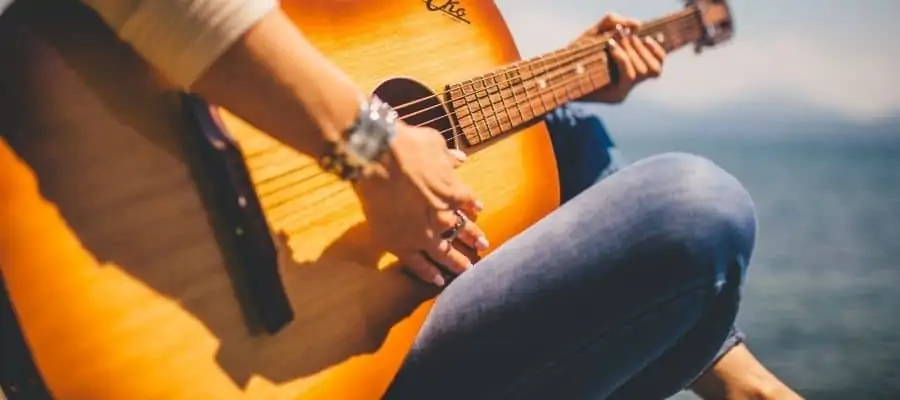
Before I go into the list and explain some of the most popular chord progressions you can find, I should address the primary question – what is a chord progression? A chord progression is a sequence of chords in a specific order based on a scale or mode.
There are many different scales you can find, and we have seven different modes. Two of the most popular ones are Ionian (or natural major) and Aeolian (or natural minor). The other five are Dorian, Phrygian, Lydian, Mixolydian, and Locrian.
Most commonly, the chord progression is based on either Ionian or Aeolian modes, and there is a specific rule on which chords you will pick.
If you are looking to learn more about modes, and music theory in general, you can always check the basic guide I wrote a while back Guitar Music Theory In-Depth Basics
Chord Progressions For Beginners
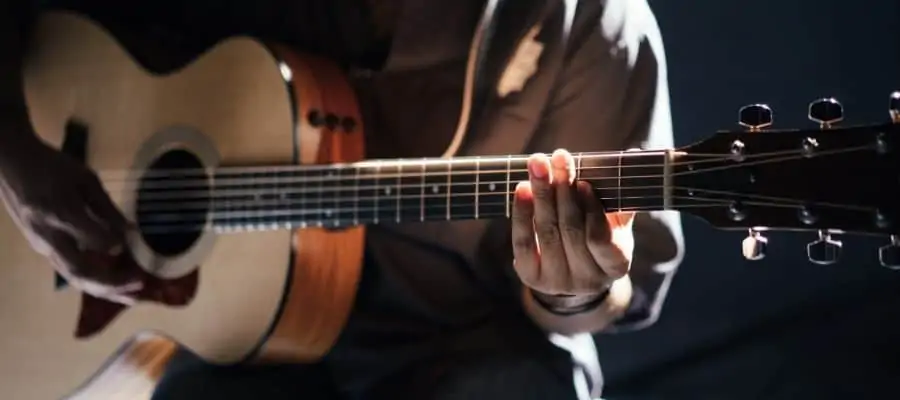
Here, my primary focus will be chord progressions for beginners. I will try to include only those with simple chords, or at least simple ideas behind them.
Em – G – Am – C (i – III – iv – VI)
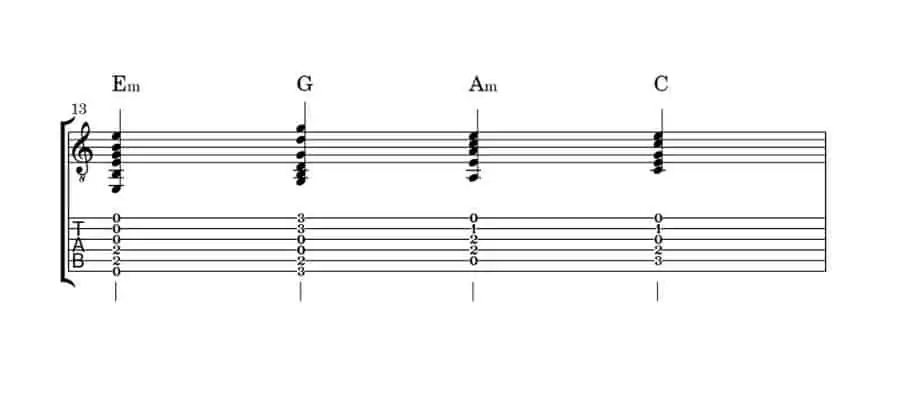
The first chord progression sounds amazing. It is a minor progression, starting on Em. The entire song will be in E minor as well, and the only problem you might have here is switching from and to G major chord.
Now, I know that the G chord can be a bit tricky for beginners, and the best course of action would be to practice it. E minor and A minor chords are quite similar, and C major is not something you’ll have problems with. So, the only real challenge here is to master the G major chord and playing it correctly.
Of course, you can always play the shorter version of the G major, which includes the third fret on the E string and the third fret on the high E string.
Am – F – C – G (i – VI – III – VII)
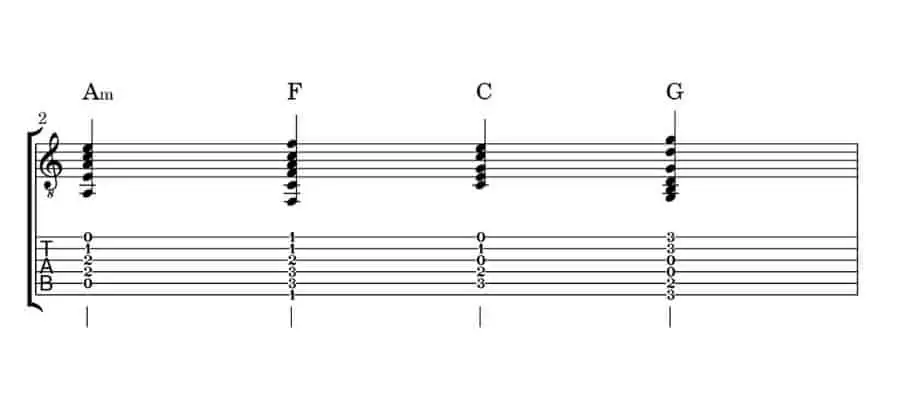
This progression is in A minor, even though the majority of the chords in progression are major ones. If you already mastered the first one on the list, this one will give you the next level of the challenge.
Yes, I’m talking about the F major chord. If you want to play the full chord, you will need to play it as a barre chord. However, it is still possible to play it without both E strings, which will allow you to easily position your fingers as with other open chords.
Another common problem for beginners is switching from C major to G major, but it is something that appears in songs quite frequently. So, the best option is to start learning it as soon as possible.
C – Am – F – Fm (I – vi – IV – iv)
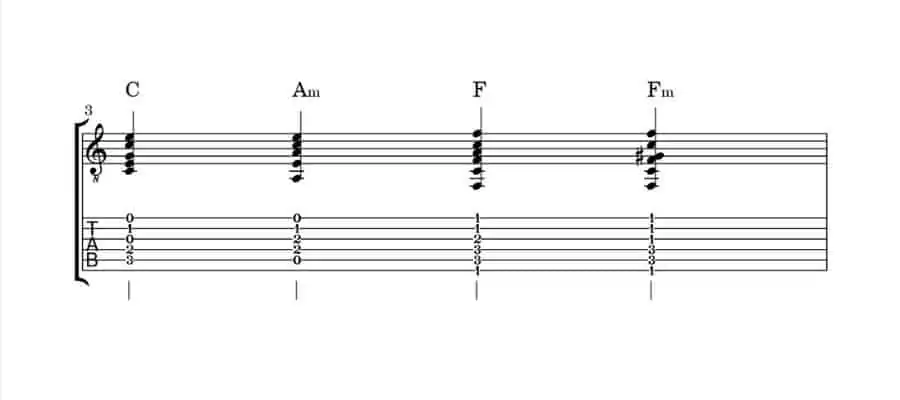
The first chord in the progression is C major, which is something many beginners are comfortable with. From there on, you will progress to A minor and then go for F major. Now, the main twist here is that you will play an F minor chord after the F major.
While it might seem strange to combine these two, the result can sound quite nice. You can also experiment with a capo if you own one since it will give a whole new dimension to the songs you play.
I should also mention that playing both the F major and F minor is possible without barring the entire neck, and it might be an easier option for those who are still learning how to play chords.
The trick is to mute the first and sixth strings and place your fingers on the four remaining strings based on the chord chart.
G – C (I – IV)
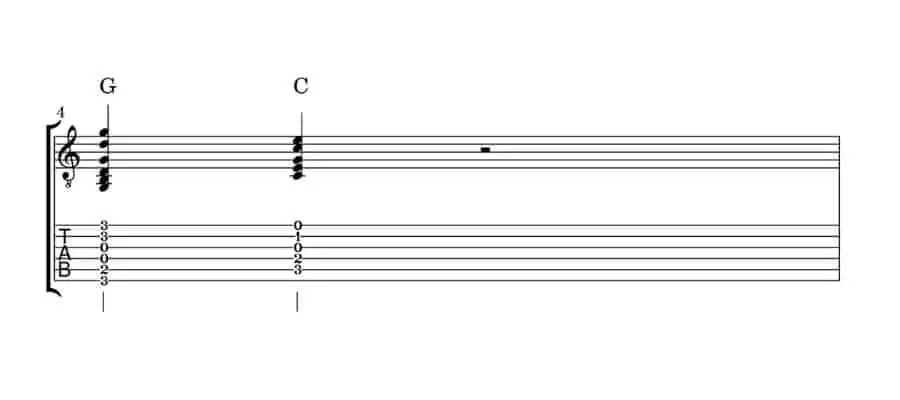
This is something I had to add to the list. G major and C major is quite a common combination, and it is one of the most problematic ones for beginner guitar players. While it is not an ideal progression if you are looking to write a song, the practice behind it is rather important.
It is also worth mentioning that G – C progression is part of so many songs, and you can add a couple of other chords to the sequence. The reason why this can be so challenging is because of the G major chord since it requires you to either play it as a barre or to stretch your fingers for the open G major chord.
Naturally, the most important thing in the process is practice, which is why this is an essential progression for all the beginners out there.
E – G#m – A – B (I – iii – IV – V)
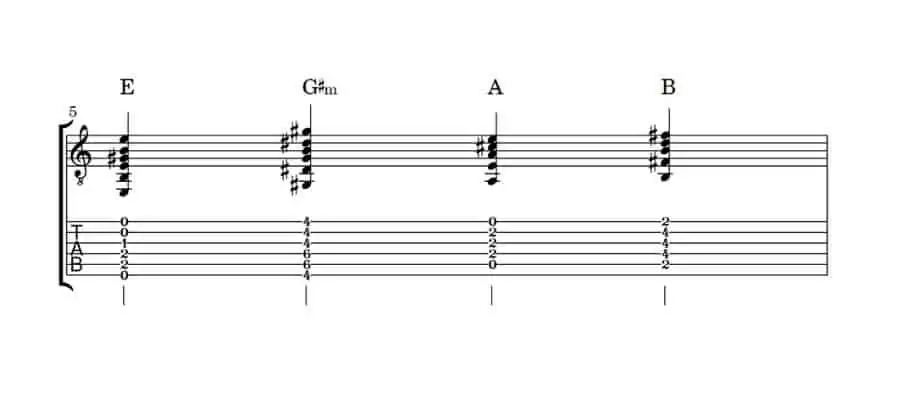
If you consider yourself to be a master of barre chords, this is an interesting progression to learn. It starts with E major, which is also the key of the entire song. After that, you will proceed to G#m which is a barre chord based on the E string.
The next one on the list is A major, and you can play the open version of this chord. Finally, the last chord is barre on the A string. There are two types of barre chords here, the minor one on the E string, and the major one on the A string.
As with previous examples, you can only fret strings that you’re playing, which will allow you to play them in the E minor and A major shape.
Am – Em (i – v)
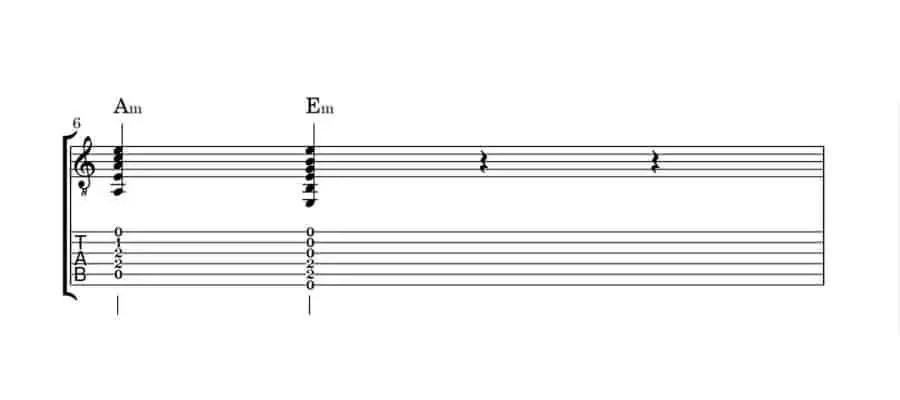
Another simple progression is A minor followed by E minor. As you can probably guess, the progression is in the minor key, and it is another important one for beginners. However, the chord sequence is quite simple to learn, and you won’t struggle with it nearly as much as with other examples on the list.
Both of these chords are open ones, and they are based on A string and E string respectively. Now, the primary reason why this is so important is that barre chords are based on these two chords (at least the minor ones).
If you took the E minor chord or shape and moved it a single fret down the neck, you would get an F minor chord. Of course, the open strings would become the first fret, and you would need to press them all with your index finger.
The same thing applies to A minor chord, but the shape will become A# once moved a fret down the neck.
G – Em- C – D (I – vi – IV – V)
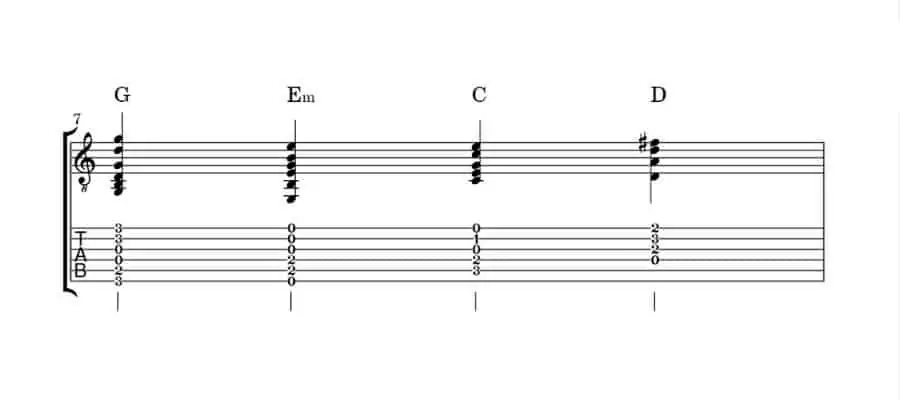
The next progression on the list is in the key of G major. It starts with G, proceeds to E minor, C major, and finishes with D major. These four chords work really well together, and it is one of the most common progressions you will find.
As with some of the other examples, the only problem here for beginners might be in G major chord. However, you can play either a shorter version of the chord or practice it enough so it isn’t a problem anymore.
Besides G major, all other chords are quite simple, and you probably won’t struggle with them at all. All things considered, this progression is worth your time, and you will be able to play so many songs with these four chords.
A – D – E (I – IV – V)
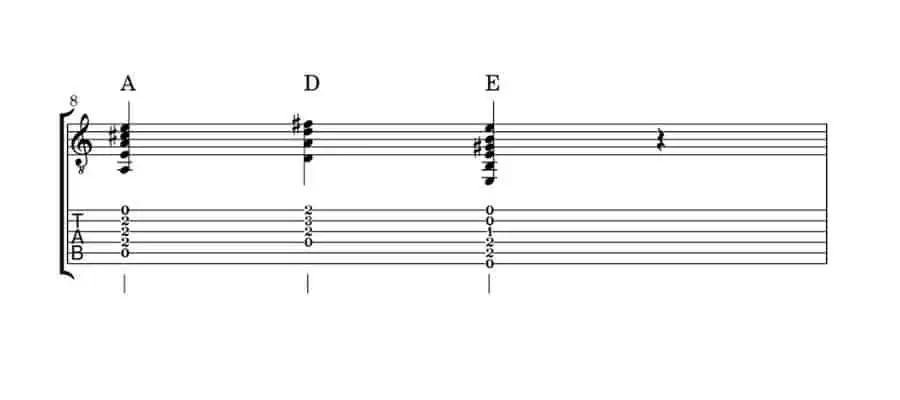
The next one is in the key of A major, and all three chords are major ones. The first one is, naturally, A major, followed by D major and E major. It is a simple yet effective progression that will allow you to learn many different songs.
Of course, the main advantage is that the chords are simple, and all three are open chords. The great advantage here is that there are many songs with these three chords, and it will allow you to perfect the D major position.
I should mention that the D major chord is based on the D string, which means that you can also shift it around the same way you can A and E major chords. However, the fingering for other positions of the D shape might be a bit tricky if you want to play them on more than three strings.
For now, you can move the D shape across the neck, and focus on playing the first three strings only. This way, you won’t need to worry about the rest, and you can play all possible major chords with this shape. The logic behind it is simple, and if you move it one fret down the neck, you will get D# major.
C – F – Am – G (I – IV – vi – V)
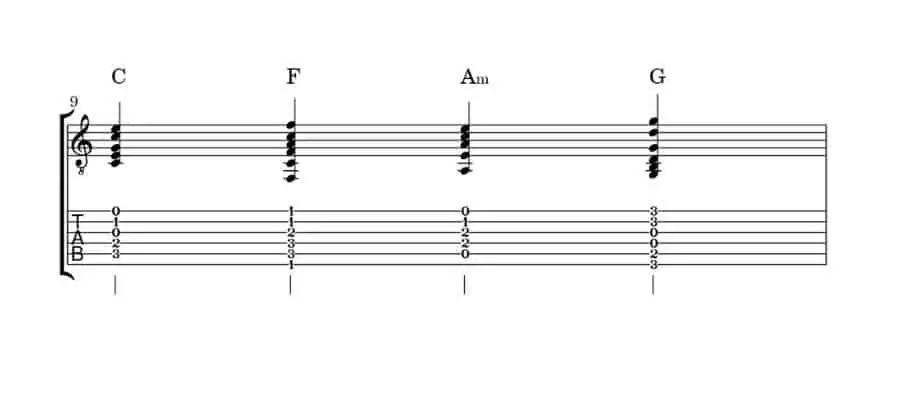
Another interesting combination of chords is in C major, and it’s followed by F major, A minor, and G major. As you can notice, you have two “problematic” chords here – F major and G major. Naturally, you can play shorter versions of the chords as I mentioned earlier, and it’s not as difficult once you get a hang of it.
The progression is quite popular in music, and there are numerous songs that follow this pattern. You can practice it with different strumming techniques, fingerpicking, or anything else that will help you improve your chord switching.
The chord sequence sounds really nice, and it is perfect for both beginners and those with a bit more experience.
G6 – Cmaj7 (I – IV)
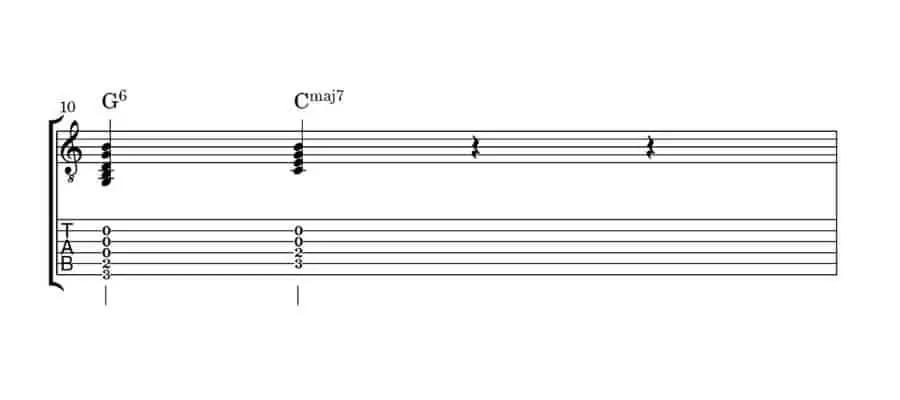
Now, the first thing you might think is that this progression is too complex for beginners. But it is, in fact, a simplified version of G – C progression. For G6, you will play the G note on the E string (third fret), and the second fret on the A string or B. The rest of the strings are open.
As for Cmaj7, the fingering is the same, only you will play it one string lower. This means that you will need to play the third fret on the A string, and the second fret on the D string. Here, you don’t need to play the sixth string at all, and it will allow you to practice switching between G and C but in this easier version.
Naturally, the sound is quite similar to the G – C progression, but you might still notice the change in the sound.
G – Em – Am – D (I – vi – ii – V)
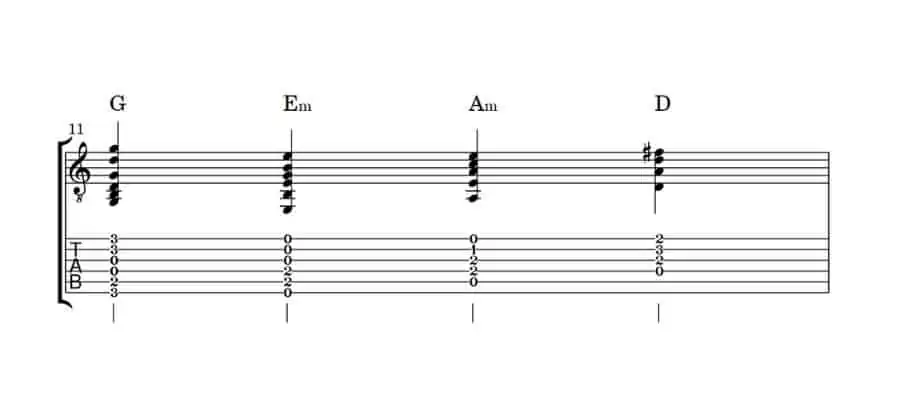
The next easy combination of chords is in G major. It starts with a G major chord followed by two minor ones E minor and A minor, and the final one is D. It’s one of the simpler progressions on the list, and you can play the shorter version of G major if it’s too complex for you.
Of course, I would suggest you practice the full G major chord, since it is something you’ll need to learn sooner or later. The rest of the progression is quite simple, and it sounds really nice when you combine it.
You don’t need to worry about speed while practicing this. It’s always better to play it correctly and on tempo. Speed is something that will come over time and with enough practice.
C – Am – Dm – G (I – vi – ii – V)
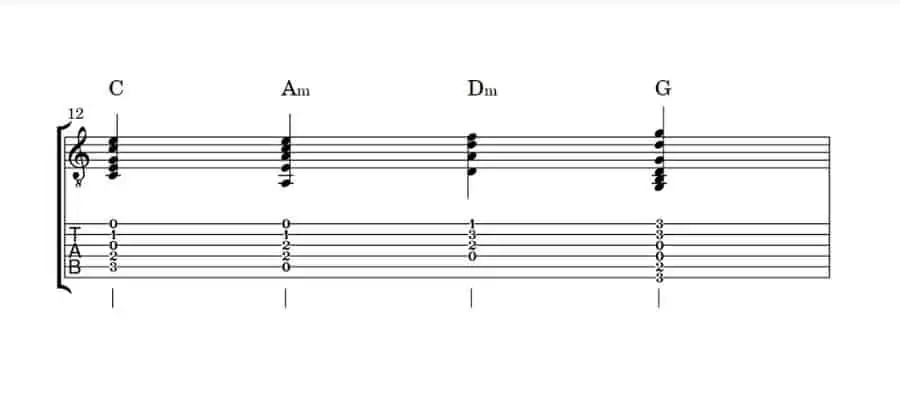
The final combination I will mention here is in C major. The progression is similar to the previous one, but it revolves around a different key. The minor chords here are A minor and D minor. It is also the only combination on the list that involves D minor chord, which is quite popular when it comes to songwriting.
Theory Behind Chord Progressions

It seems wrong not to mention the theory and logic behind chord progressions here. I already talked about different modes you can find, and the majority of scales here are either minor or major. But what does scale have to do with a chord progression?
If we take a look at C major scale, we have C, D, E, F, G, A, B, and C. There are seven different notes in this scale. We can assign a number to each of the notes on a scale, and usually, musicians use Roman numerals.
On a major scale, the numbering goes like this I – ii – iii – IV – V – vi – vii⁰. The capital letters are major chords, lowercase letters are minor, and the last one is diminished. So, when you talk about chord progressions, the common way to write them is I – IV – V. This means that all three chords will be major ones, and in the scale of C major, the progression is C – F – G.
This way, you can easily change the key of the song without wondering about positions. You can use the same method for any progression on the list, and all you need to do is write the numbers above each of the chords.
For more info about chord progressions and how they are built, you can check the article 24 Guitar Chord Progression You Must Learn (Common, Rock, Sad, Jazz). You will also find a full table for major and minor scales.
Summary
Chords are a basic structure of every song. It is necessary to learn how to play them, and it will help you progress faster on your learning. But these chords aren’t used in a random manner, and there are a couple of rules you need to know.
Here, you can find some of the most common progressions, and it is a perfect place to start learning if you are inexperienced in the area.
Once you master these progressions, you can experiment with different keys, sequences, and patterns to create beautiful and unique music.
If you found this article useful, you may want to save this pin below to your Guitar board.
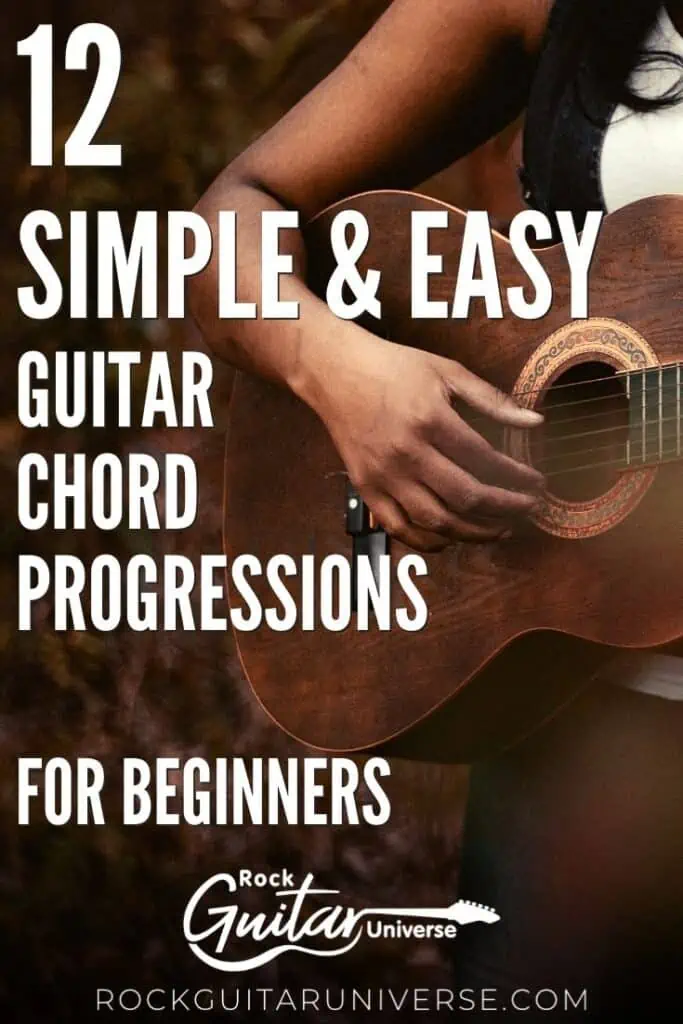
One thought on “12 Simple & Easy Guitar Chord Progressions For Beginners”
Leave a Reply
Recent Posts
When learning new songs have you noticed that some of the chord sequences sound really good? But when you tried to come up with your own chord sequence, or as we call it chord progression, you found...
Some guitarists insist on buying an expensive amplifier with their electric guitar. They assume that this is a must for every type of guitarist out there. However, in some situations, this isn’t...

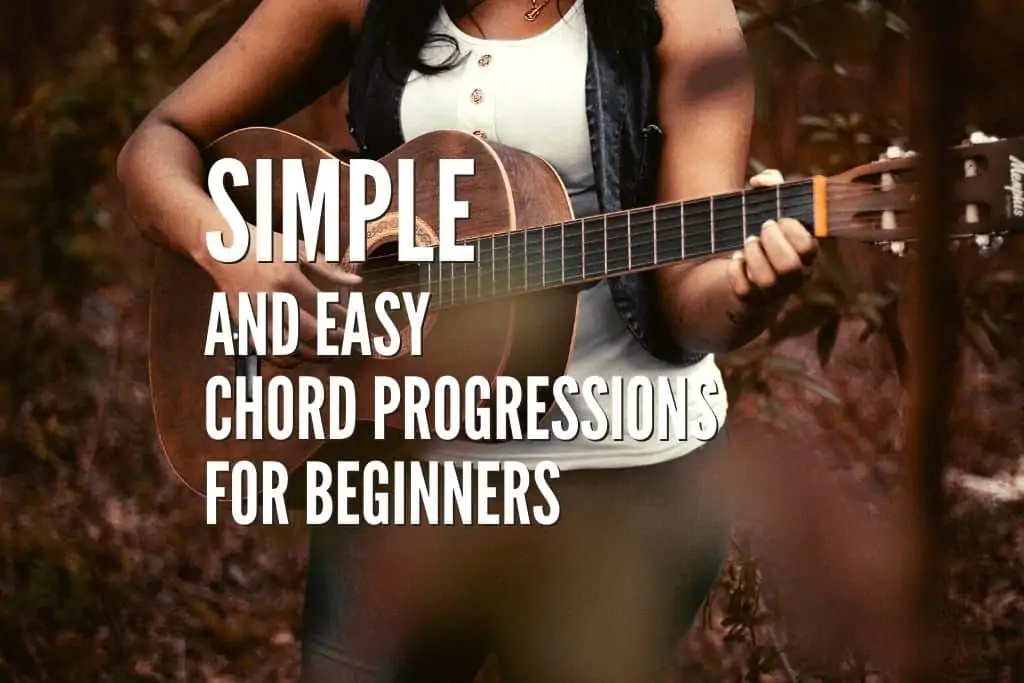
Very good article and easy to understand. I will start trying some of these progressions. Thanks